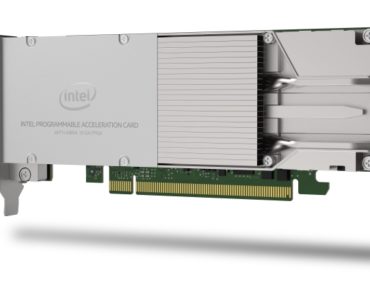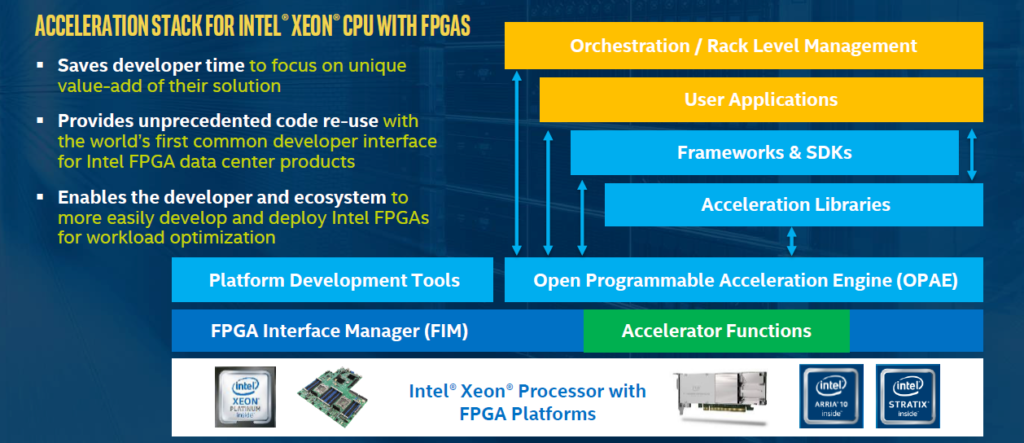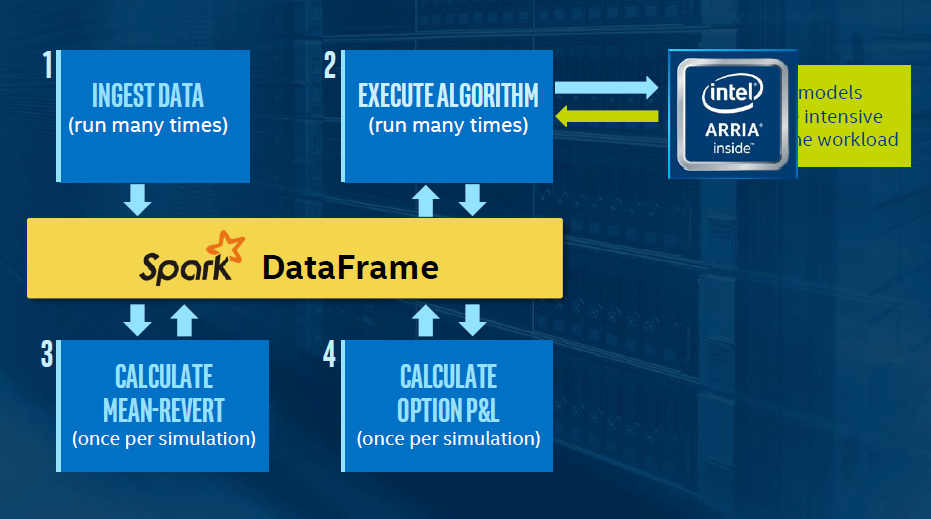Intel Accelerates FPGAs into Server Mainstream with Dell EMC, Fujitsu

The rapid emergence of heterogeneous, accelerated computing in the advanced scale computing market took a step forward this week with two significant announcements designed to broaden adoption of lightning-quick FPGAs within mainstream x86 computing infrastructures. The news comes on the heels of the stir created last month by growing market traction for IBM’s Power9 chip and OpenPower platform, tightly linking IBM CPUs with GPUs; followed by “GPU-mania” at Nvidia’s GTC conference, highlighting the growing number of workloads coming under the purview of GPUs.
On the FPGA front, acceleration-as-a-service company Accelize on Monday launched a cloud-based “marketplace,” offering accelerator functions from an ecosystem of third-party developer companies that can be deployed on public cloud FPGA instances.
And this morning, Intel announced adoption of its Programmable Acceleration Card (PAC), with Arria 10 GX FPGA and the Intel Acceleration Stack for Intel Xeon CPU, within the server lineups of Dell-EMC and Fujitsu. The “deployment ready” Acceleration Stack includes APIs and software that abstract away the need for complex (and often unfamiliar) FPGA programming, enabling FPGAs to accelerate workloads within widely used Intel Xeon computing environments. According to Intel, compute-heavy portions of financial analytics and database applications have been offloaded to Arria FPGAs for performance improvements of 8x and 20x, respectively.
Dell EMC PowerEdge R640, R740 and R740XD servers incorporating Intel FPGA are on the market now; Fujitsu Primergy RX2540 M4 servers with Intel FPGAs are available to priority customers now and the general market in the second half of this year.
Intel’s acquisition of Altera in 2015 for $16.7 billion declared to the world Intel’s strategic commitment to FPGA technology. CEO Brian Krzanich and other senior Intel managers have predicted that a third of servers used by the major cloud computing hyperscalers could have hybrid CPU/FPGA nodes by 2020.
“We look at this as a pivotal moment where we have adoption by the top-tier OEMs enabling broader move into the enterprise market,” Sabrina Gomez, director, Intel Programmable Solutions Group, told EnterpriseTech ahead of today’s announcement.
“We have a solution where we have the FPGA coupled with the Xeon CPUs and all of the required layers that help provide a platform for acceleration,” Gomez said. “One of the key pieces: software. That’s where the stack plays a really important role in being the API driver layer, to enable software developers to leverage the power of the FPGA in offloading and accelerating high compute-intensive, repetitive functions.”
Industry watcher Patrick Moorhead, said he views today’s announcement “as the beginning of the popularization of FPGAs. Dell EMC wouldn’t productize unless they had customers who want to buy them.”
“One big benefit that FPGAs have is that they can be hardware programmable,” Moorhead said. “One day they can be doing deep packet network inspection and the next hour they can be doing machine learning for inferencing. Not every datacenter needs morphing like that, but some will. I also like that FPGAs only consume power based on the gates used.”
 The biggest benefit of FPGAs, of course, is blazing, parallel processing speed. Intel pointed to performance improvements while working with two PAC partners, the strategy in both cases being to assign the compute-heavy portions the workloads to the FPGA.
The biggest benefit of FPGAs, of course, is blazing, parallel processing speed. Intel pointed to performance improvements while working with two PAC partners, the strategy in both cases being to assign the compute-heavy portions the workloads to the FPGA.
In financial risk analytics, Intel has partnered with Levyx, a provider of high-performance big data processing software, to build a back testing solution for financial institutions. As Gomez explained it, end-to-end options trading simulation is conducted in four blocks: data ingest, algorithm execution, “mean revert” calculation and the final P&L calculation of the option.
 “The algorithm piece is the one that takes up the most time and also runs repetitively,” she said, “so that’s a perfect fit for offloading to FPGA acceleration off of the software running on the CPU. You offload that, you’re running it in parallel and you have the flexibility of the FPGA, so if that model changes… you can make changes in the workload. And you get the overall benefit for the whole pipeline for this algorithmic calculation because you’ve offloaded a big chunk of it, and you’ve accelerated that big chunk.”
“The algorithm piece is the one that takes up the most time and also runs repetitively,” she said, “so that’s a perfect fit for offloading to FPGA acceleration off of the software running on the CPU. You offload that, you’re running it in parallel and you have the flexibility of the FPGA, so if that model changes… you can make changes in the workload. And you get the overall benefit for the whole pipeline for this algorithmic calculation because you’ve offloaded a big chunk of it, and you’ve accelerated that big chunk.”
According to Intel and Levyx, the execution piece of the workload was accelerated 8x compared with running it in software only, while across all four stages of the entire model performance was more than doubled.
“Financial modeling is a big data problem with huge performance sensitivities,” said Matt Meinel, senior vice president of business development for Levyx. “Utilizing the Intel PAC and the Acceleration Stack, our architects and software developers achieved an eight-fold improvement in algorithm execution and twice the speed in options calculation compared to traditional Spark implementations.”
For database acceleration, Intel has partnered with Swarm64, which provides accelerators for relational databases that enable real-time analytics of high velocity data. Gomez said the goal is overcoming the performance challenges posed by hybrid databases to analytics of transaction data in the retail industry, where queries can take hours to complete.
 “If you’re doing analysis of customer buying patterns in retail, you capture all transaction data in history, you put it in the database, you need to do the ETL phase and move all that data into the data warehouse for the analytics stage, then run the analytics,” Gomez said. The ETL phase is highly time consuming, “and that’s the challenge, because to do the analysis and make decisions faster and get more meaningful information, you want that as close to real time as possible.”
“If you’re doing analysis of customer buying patterns in retail, you capture all transaction data in history, you put it in the database, you need to do the ETL phase and move all that data into the data warehouse for the analytics stage, then run the analytics,” Gomez said. The ETL phase is highly time consuming, “and that’s the challenge, because to do the analysis and make decisions faster and get more meaningful information, you want that as close to real time as possible.”
The ETL and analytics functions within the Apache Spark implementation were offloaded to FPGAs, and the results, Gomez said, “are amazing.” Analytics was accelerated by 20x, data warehousing by 2x and storage compression by 3x.
“We are at the horizon of a new era of data center computing as Dell EMC and Fujitsu put the power and flexibility of Intel FPGAs in mainstream server products,” said Reynette Au, vice president of marketing for the Intel Programmable Solutions Group. “We’re enabling our customers and partners to create a rich set of high-performance solutions at scale by delivering the benefits of hardware performance, all in a software development environment.”










